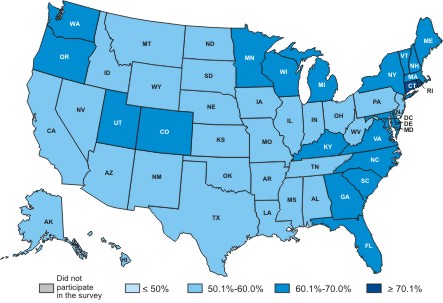Colorectal Cancer Screening Rates
Prevention and Early Detection: Keys to Reducing Deaths
Reducing the number of deaths from colorectal cancer depends on detecting and removing precancerous colorectal polyps, as well as detecting and treating the cancer in its early stages.
- Colorectal cancer can be prevented by removing precancerous polyps or abnormal growths, which can be present in the colon for years before invasive cancer develops.
- When colorectal cancer is found early and treated, the 5-year relative survival rate is 90%. Because screening rates are low, less than 40% of colorectal cancers are found early.
- One U.S. clinical trial reported a 33% reduction in colorectal cancer deaths and a 20% reduction in colorectal cancer incidence among people offered an annual fecal occult blood test (FOBT).
Percentage* of adults aged ≥50 years who reported receiving a FOBT within the past year and/or a lower endoscopy† within the past 10 years, by state—Behavioral Risk Factor Surveillance System (BRFSS), United States, 2006‡

| Interval | States | |
|---|---|---|
| Light blue | Less than 50.0 | None |
| Medium blue | 50.1 to 60.0 | Alabama, Alaska, Arizona, Arkansas, California, Hawaii, Idaho, Illinois, Indiana, Iowa, Kansas, Louisiana, Mississippi, Missouri, Montana, Nebraska, Nevada, New Jersey, New Mexico, North Dakota, Oklahoma, Ohio, Pennsylvania, South Dakota, Texas, Tennessee, West Virginia, and Wyoming |
| Royal blue | 60.1 to 70.0 | Colorado, Delaware, District of Columbia, Florida, Georgia, Kentucky, Maine, Maryland, Massachusetts, Michigan, Minnesota, New Hampshire, New York, North Carolina, Oregon, South Carolina, Utah, Vermont, Virginia, Washington, and Wisconsin |
| Dark blue | Connecticut and Rhode Island |
*Age-standardized to the 2006 BRFSS population age ≥ 50.
† Lower endoscopy refers to flexible sigmoidoscopy or colonoscopy.
‡ Source: Centers for Disease Control and Prevention (CDC). Behavioral Risk Factor Surveillance System Survey Data. Atlanta, Georgia: U.S. Department of Health and Human Services, Centers for Disease Control and Prevention, 2007.
Percentage* of adults aged ≥50 years who reported receiving a FOBT within the past year and/or a lower endoscopy† within the past 10 years, by state—Behavioral Risk Factor Surveillance System (BRFSS), United States, 2004‡

| Interval | States | |
|---|---|---|
| Light blue | Less than 50.0 | Arkansas, Idaho, Mississippi, Nevada, and Oklahoma |
| Medium blue | 50.1 to 60.0 | Alabama, Alaska, Arizona, California, Colorado, Florida, Georgia, Iowa, Kansas, Kentucky, Illinois, Indiana, Louisiana, Missouri, Montana, Nebraska, New Jersey, New Mexico, New York, North Dakota, Ohio, Oregon, Pennsylvania, South Carolina, South Dakota, Tennessee, Texas, Utah, West Virginia, and Wyoming |
| Royal blue | 60.1 to 70.0 | Connecticut, Delaware, District of Columbia, Maine, Maryland, Massachusetts, Michigan, Minnesota, New Hampshire, North Carolina, Rhode Island, Vermont, Virginia, Washington, and Wisconsin |
| Dark blue | None | |
| Gray | Hawaii |
*Age-standardized to the 2006 BRFSS population age ≥ 50.
† Lower endoscopy refers to flexible sigmoidoscopy or colonoscopy.
‡ Source: Centers for Disease Control and Prevention (CDC). Behavioral Risk Factor Surveillance System Survey Data. Atlanta, Georgia: U.S. Department of Health and Human Services, Centers for Disease Control and Prevention, 2005.
Underuse of Screening
- Colorectal cancer screening remains underused, despite the availability of effective screening tests.
- Screening for colorectal cancer lags far behind screening for breast and cervical cancers.
- Findings from the National Health Interview Survey (NHIS), which is administered by CDC, indicate that in 2000, only 42.5 percent of U.S. adults age 50 or older had undergone a sigmoidoscopy or colonoscopy within the previous 10 years or had used a fecal occult blood test (FOBT) home test kit within the preceding year.
- Screening for colorectal cancer was particularly low among those respondents who lacked health insurance, those with no usual source of health care, and those who reported no doctor's visits within the preceding year.
- As many as 60% of deaths from colorectal cancer could be prevented if everyone age 50 and older were screened regularly.
For more information, visit Screening and Risk Factors Report: Had a Sigmoidoscopy or Colonoscopy in Past 5 Years, 2006, All Races, Both Sexes, Ages 50+ and Screening and Risk Factors Report: Used Home Blood Stool Test in Past Year, 2006, All Races, Both Sexes, Ages 50+.
Contact Us:
- Centers for Disease Control and Prevention
Division of Cancer Prevention and Control
4770 Buford Hwy NE
MS K-64
Atlanta, GA 30341 - 800-CDC-INFO
(800-232-4636)
TTY: (888) 232-6348
24 Hours/Every Day - cdcinfo@cdc.gov


